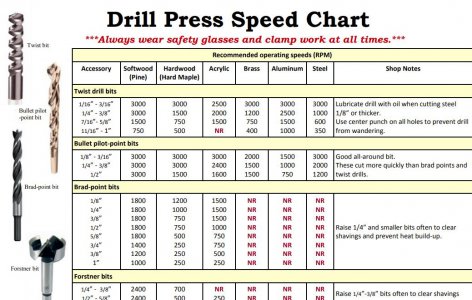Looking at drilling into steel and aluminum. Mainly plates and sheet.
So I was looking up some speed charts to put next to my drill press and found that many of the speed charts recommend high RPMs. I was always under the impression, as a general rule, that the harder the material and the larger the hole the slower you wanted to go. So I was kind of surprised that many of these are recommending 1000rpms for 1/4"-3/8" holes and 3000rpms for anything below that.
Seems high and likely to produce a bunch of heat...? Doesn't that kill the drill bit? Should I be going with these recommendations or backing off the speeds a little? What has experience shown you?
Forum won't let me link sites so here's a pic of one I grabbed off the net.

for
So I was looking up some speed charts to put next to my drill press and found that many of the speed charts recommend high RPMs. I was always under the impression, as a general rule, that the harder the material and the larger the hole the slower you wanted to go. So I was kind of surprised that many of these are recommending 1000rpms for 1/4"-3/8" holes and 3000rpms for anything below that.
Seems high and likely to produce a bunch of heat...? Doesn't that kill the drill bit? Should I be going with these recommendations or backing off the speeds a little? What has experience shown you?
Forum won't let me link sites so here's a pic of one I grabbed off the net.

for


